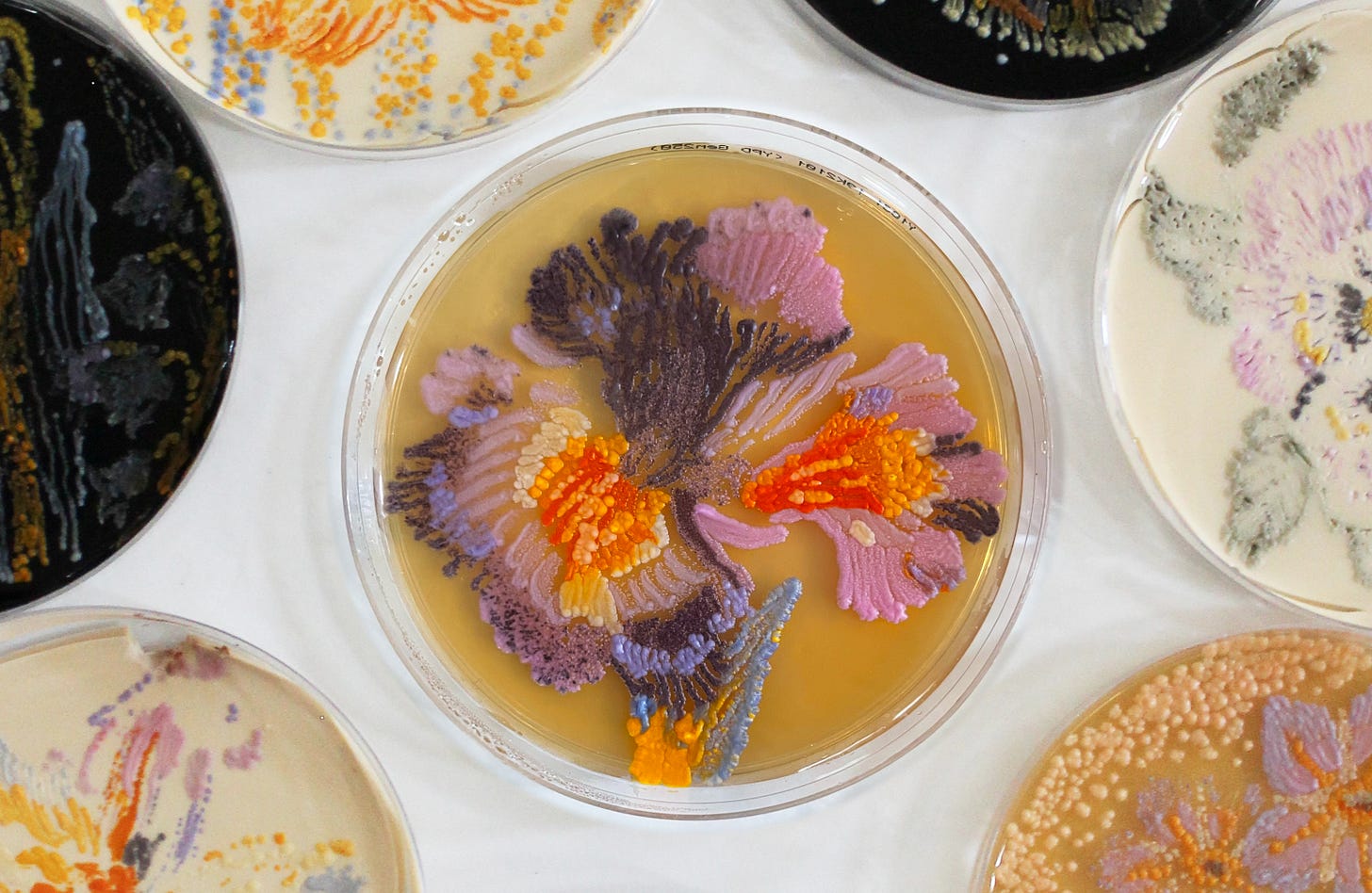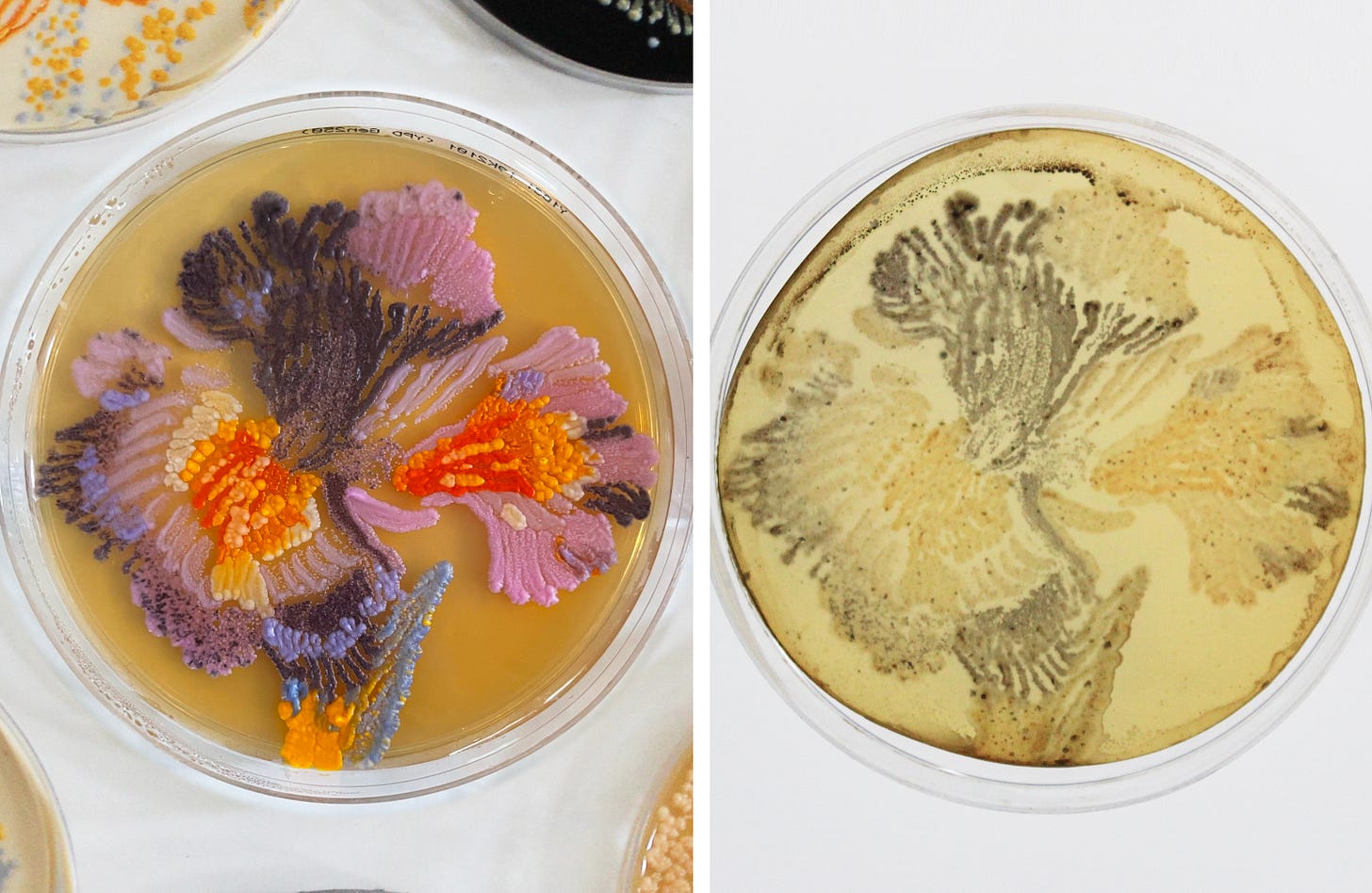
Iris #1 (Rockaway Beach)
My first yeast painting was an Iris. I had received the beautiful, rich yeast palette from the Boeke lab and I was going to teach a “Art of Synbio” class at Genspace with Beth Tuck that included painting with yeast. It was June, and I was casting about for ideas of things to paint. I came across some irises (that had likely been planted by parks) while I was riding my bike along the boardwalk in Rockaway Beach, NYC. I stopped to take some photos, and they became the inspiration for my first yeast painting.
The colors in the yeast palette from the Boeke lab enabled me to work with microbes in a way that felt familiar. I am educated as a painter and printmaker, and the palette of rich colors was delightful to me. I was excited to delve into the process; a process which I modeled on the same processes I used in printmaking (more on this in a future post). I painted several other flowers but of the first batch, the Iris was my favorite and has remained one of my favorite flowers to paint.

Bold Blue, Shy Blue, No Blue
The palette contained several colors with DNA from sea creatures, the beta carotene metobolic pathway (found in carrots, sweet potatoes, red peppers), and the violacein pathway (found in bacteria). The colors that transformed the most over time were an anenome blue and the yellow and red in the beta carotene pathway. I must admit that the blue was my favorite. Sometimes the blue was dark and vibrant, sometimes it was pale, and sometimes the yeast wouldn’t render the blue at all.

Van Gogh’s Irises
I hadn’t known what to expect with this first Petri dish painting, but to me, the lines of this particular Petri dish painting resembled Van Gogh’s irises. I did a quick search of his Iris works and learned that the paintings as we know them now are quite different than how he intended them; the colors have faded with time. The Met notes of the Iris still lifes in its collection, “In the Museum’s Irises he sought a “harmonious and soft” effect by placing the “violet” flowers against a “pink background,” which have since faded owing to his use of fugitive red pigments.”
Iris 1 (Rockaway) Life phases

I was fond of this Iris and kept it. Over time, the agar began to dehydrate and the color faded. A year later, the flower was still visible, but it looked a dried flower or a drawing on parchment.
I enjoy comparing images of the Iris at its most saturated state, and at a later state.

Radical Flowers
So, are flowers having a moment? A piece in the NY Times last year entitled “Is There Something Radical About Painting Flowers?” muses “the last time flower paintings had a moment akin to the current one was arguably in the ’80s and early ’90s, against the backdrop of the AIDS epidemic.” The article shares perspectives from many artists including figure painter Jordan Casteel who has recently migrated more towards flowers.
Late last year I was invited to visit SUNY New Paltz F&PA (school of fine and performing arts) by invitation of the Student Art Alliance. I gave a lecture in the morning and spent the rest of the day visiting studios. I was impressed by the work of both the faculty and students; one highlight was the paintings of grad student, Melany Garcia Mercedes. I asked her if I could take a photo and upon taking the picture I felt humbled; like I had captured magic mid process. Her compositions were rich, lush vibrant, with the only humanity—a hint of chain link fence—being engulfed by the landscape.
Thanks for joining me on this meandering journey about flowers.
Why Flowers?
To me, flowers represent an interface between humans and nature. They are significant to us culturally, politically, scientifically. This piece is the first in a series, “Why Flowers?” in which I will share my thoughts and context around flowers and why they are an inspiration in my work.
Thanks for reading! Please share any thoughts you may have.








Love the “dried parchment” dead painting! So cool.